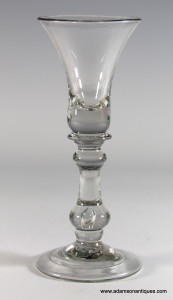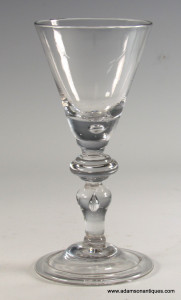about Balusters Balusters & Plain Stems
Much has been written about Baluster glasses and their evolution - mostly repeated from publications that are now between 50 and 100 years out of date. Over the years I have been very fortunate to have been in frequent contact with several eminent researchers and writers on the subject of early English glass and its development. This has allowed me to keep abreast of the latest information - knowledge that I am always pleased to share with those of similar interests.
For a history and development of English lead glass and its continental connections as they are understood today it is well worth obtaining a copy of The Golden Age Of English Glass: 1650-1775 by D P Lanmon, FSA (ex curator of glass at Corning Museum).
At the birth of English lead glass most vessels produced were made in the Façon de Venise style - still showing the influence of the wonderful Italian products which had dominated the world of glass for centuries. As the 17th century progressed towards its end the uniquely English Balusters began to appear. Makers discovered that the slower cooling and therefore more workable lead metal lent itself perfectly to the creation of the many wonderful heavier and stronger, boldly knopped Baluster glasses that are much admired and collected today.
The knopping of Balusters began with an inversion of the simple architectural feature the Baluster column widening at its base. From the 1690s we begin to see the many and varied knops that we now know, starting with the inverted baluster and quickly followed by the acorn and mushroom, the angular and annular and the true baluster along with the great rarities of today: the Egg and the Cylinder.
It was also at this time that various foot forms were introduced including the domed, domed and folded, terraced and the rare beehive foot. These, along with the standard conical which could be plain or folded, added much more variety than had been previously available. Most forms of glass can be found in the baluster period; cordials, wines, sweetmeats, drams, ales and of course wonderful goblets all of which are a delight to both the eye and the hand - being very tactile and superb to use today by the careful collector.
All the major knop varieties are contained in the Adamson collection and new glasses will be offered regularly.
Plain stems perhaps need little explanation. The huge variety of plain stem vessels with almost all bowl types and foot variations can be a very satisfying area for collectors of these iconic English antique drinking glasses - which are anything but plain.















































